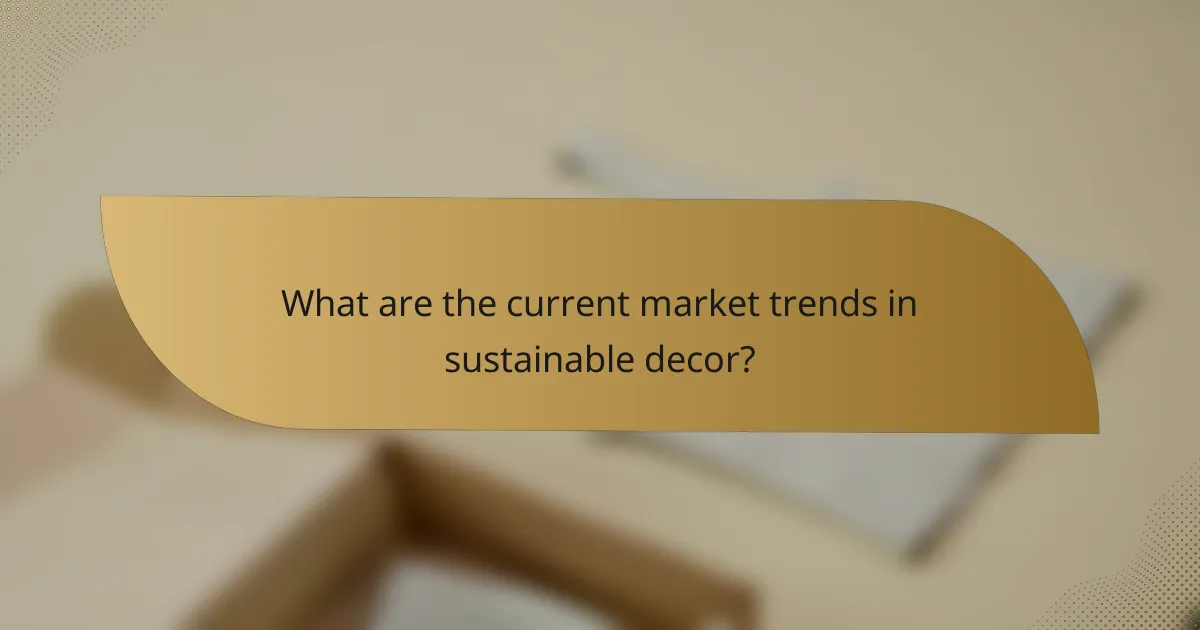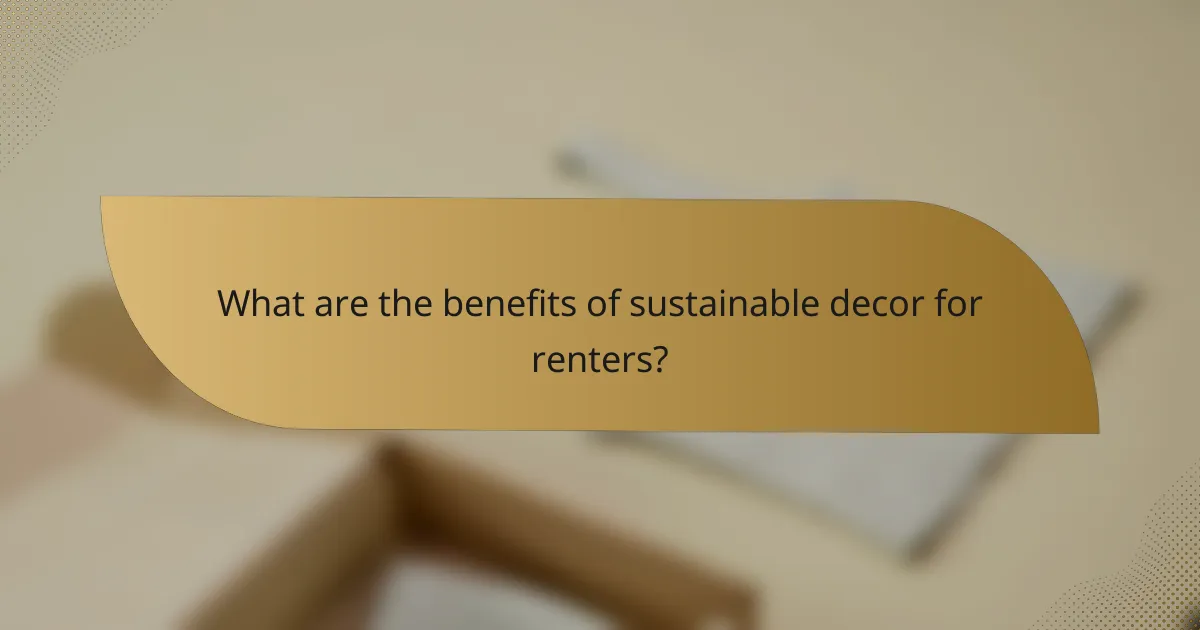Sustainable decor is becoming a crucial factor in enhancing home value and marketability, as properties featuring eco-friendly materials and designs tend to attract higher appraisals. With a growing consumer demand for environmentally conscious choices, homeowners are increasingly prioritizing sustainable elements that not only improve aesthetics but also create healthier living environments. This trend not only appeals to buyers but also contributes to quicker sales and increased property values in a competitive real estate market.

How does sustainable decor impact home value?
Sustainable decor can positively influence home value by enhancing property appeal and marketability. Homes featuring eco-friendly materials and designs often attract higher appraisals and resale prices, making them more desirable in the competitive real estate market.
Increased property appraisal
Sustainable decor can lead to increased property appraisals as appraisers recognize the value of energy-efficient features and environmentally friendly materials. Homes with solar panels, high-efficiency appliances, and sustainable landscaping often receive higher ratings due to their long-term cost savings and reduced environmental impact.
Consider investing in certified green upgrades, as they can significantly boost your home’s appraisal value. Features that meet recognized standards, such as LEED or Energy Star certifications, are particularly appealing to appraisers.
Higher resale prices
Properties with sustainable decor typically command higher resale prices compared to traditional homes. Buyers are increasingly willing to pay a premium for homes that offer energy efficiency and lower utility costs, which can translate to thousands of dollars in added value.
Research indicates that homes with green features can sell for 5-15% more than comparable properties without such features. This trend is particularly strong in urban areas where eco-conscious living is prioritized.
Attractiveness to eco-conscious buyers
Sustainable decor is particularly attractive to eco-conscious buyers who prioritize environmental responsibility in their purchasing decisions. These buyers often seek homes that reflect their values, making properties with green features more appealing.
To attract this demographic, consider incorporating sustainable materials, energy-efficient systems, and water-saving fixtures. Highlighting these features in listings can significantly increase interest and lead to quicker sales.

What are the current market trends in sustainable decor?
Current market trends in sustainable decor show a significant shift towards environmentally friendly choices, driven by consumer demand and awareness. Homeowners increasingly prioritize eco-friendly materials, energy-efficient appliances, and biophilic design elements, which enhance both aesthetics and sustainability.
Growing demand for eco-friendly materials
The demand for eco-friendly materials is rising as consumers seek to reduce their environmental footprint. Materials such as bamboo, reclaimed wood, and recycled metals are becoming popular choices for furniture and decor. These options not only minimize waste but also often come with unique aesthetics that appeal to buyers.
When selecting eco-friendly materials, consider certifications like FSC (Forest Stewardship Council) for wood products or GREENGUARD for low-emission materials. This ensures that your choices are genuinely sustainable and contribute positively to indoor air quality.
Popularity of energy-efficient appliances
Energy-efficient appliances are increasingly favored in sustainable decor, as they lower utility bills and reduce energy consumption. Products with ENERGY STAR ratings are particularly sought after, as they meet strict efficiency guidelines set by the U.S. Environmental Protection Agency.
Investing in energy-efficient appliances can enhance a home’s appeal to potential buyers. For instance, modern refrigerators, dishwashers, and washing machines that consume less energy can be a strong selling point, especially in markets where energy costs are high.
Rise of biophilic design elements
Biophilic design, which incorporates natural elements into interior spaces, is gaining traction in sustainable decor. This trend includes the use of indoor plants, natural light, and organic shapes to create a connection with nature. Such elements not only enhance the aesthetic appeal but also promote well-being and reduce stress.
To implement biophilic design, consider adding features like living walls, large windows for natural light, or water features. These additions can significantly increase a home’s market value and attract buyers looking for a serene, nature-inspired environment.

How does sustainable decor enhance buyer appeal?
Sustainable decor significantly enhances buyer appeal by creating healthier living environments and reducing long-term costs. Homebuyers increasingly prioritize eco-friendly features, which can lead to higher market value and quicker sales.
Improved indoor air quality
Sustainable decor often incorporates non-toxic materials and finishes, which contribute to improved indoor air quality. This can include low-VOC paints, natural fibers, and sustainably sourced wood. Homes with better air quality are more attractive to buyers concerned about health and wellness.
To enhance indoor air quality, consider using air-purifying plants or installing ventilation systems that meet current standards. Regular maintenance of these systems ensures continued benefits.
Lower utility costs
Incorporating energy-efficient appliances and sustainable materials can lead to significantly lower utility costs. Features such as LED lighting, high-efficiency HVAC systems, and proper insulation can reduce energy consumption by a notable percentage.
Homebuyers appreciate the potential for savings on monthly bills, making energy-efficient homes more appealing. When showcasing a property, highlight these features and provide estimates of potential savings to attract buyers.
Positive environmental impact
Using sustainable decor contributes to a positive environmental impact, which resonates with eco-conscious buyers. This includes reducing waste, conserving resources, and minimizing carbon footprints through responsible sourcing and production practices.
Promoting the environmental benefits of a home can be a strong selling point. Consider providing information on certifications like LEED or Energy Star, which can validate the home’s eco-friendly features and enhance its marketability.

What are the key criteria for selecting sustainable decor?
When selecting sustainable decor, focus on material sourcing, energy efficiency, and durability. These criteria not only enhance the environmental impact of your home but also contribute to its overall value and appeal in the market.
Material sourcing and certifications
Choosing decor made from sustainably sourced materials is crucial. Look for products that use renewable resources, such as bamboo or reclaimed wood, and check for certifications like FSC (Forest Stewardship Council) or Cradle to Cradle, which indicate responsible sourcing practices.
Additionally, consider the lifecycle of materials. Items that are biodegradable or recyclable at the end of their life cycle can significantly reduce environmental impact. This approach not only benefits the planet but can also attract eco-conscious buyers.
Energy efficiency ratings
Energy efficiency ratings are essential when selecting decor that impacts your home’s energy consumption. Look for products with Energy Star ratings or similar certifications, which indicate that they meet strict energy efficiency guidelines.
Incorporating energy-efficient lighting, appliances, and insulation can lead to lower utility bills and a reduced carbon footprint. This not only enhances your living space but can also increase your home’s market value as buyers increasingly prioritize energy efficiency.
Durability and maintenance
Durability is a key factor in sustainable decor, as longer-lasting materials reduce the need for replacements and waste. Opt for items made from high-quality materials that can withstand wear and tear, such as solid wood furniture or metal fixtures.
Maintenance requirements also play a role in sustainability. Choose decor that is easy to clean and maintain, minimizing the use of harsh chemicals. This not only benefits the environment but also ensures that your home remains appealing to potential buyers.

How can homeowners implement sustainable decor?
Homeowners can implement sustainable decor by selecting eco-friendly materials, choosing energy-efficient products, and supporting brands that prioritize sustainability. These practices not only enhance the aesthetic of a home but also contribute positively to the environment and can increase property value.
Choosing sustainable furniture brands
Selecting sustainable furniture brands involves looking for companies that use responsibly sourced materials and ethical manufacturing processes. Brands that are certified by recognized organizations, such as the Forest Stewardship Council (FSC), ensure that their wood products come from sustainably managed forests.
Additionally, consider brands that offer furniture made from recycled or upcycled materials. This not only reduces waste but also often results in unique, stylish pieces that stand out in your home.
Incorporating recycled materials
Incorporating recycled materials into home decor can significantly reduce environmental impact. Items like reclaimed wood for furniture or decor, recycled glass for lighting fixtures, and textiles made from recycled fibers can add character while being eco-friendly.
When choosing recycled materials, look for certifications that verify the material’s origin and sustainability. This ensures that the materials are not only recycled but also safe and durable for use in your home.
Utilizing energy-efficient lighting
Utilizing energy-efficient lighting is a straightforward way to enhance sustainable decor. Switching to LED bulbs can reduce energy consumption by up to 80% compared to traditional incandescent bulbs, leading to lower electricity bills and a smaller carbon footprint.
In addition to choosing energy-efficient bulbs, consider installing smart lighting systems that allow for better control over energy use. These systems can be programmed to turn off lights when not needed, further promoting sustainability in your home.

What are the benefits of sustainable decor for renters?
Sustainable decor offers renters numerous advantages, including improved indoor air quality and lower utility costs. By choosing eco-friendly materials and energy-efficient designs, renters can create a healthier living environment while potentially increasing their overall comfort and satisfaction.
Improved indoor air quality
Sustainable decor often incorporates non-toxic materials and finishes, which can significantly enhance indoor air quality. For instance, using low-VOC paints and natural fiber furnishings reduces harmful emissions that can lead to respiratory issues. Renters should prioritize materials that are certified for low emissions to ensure a healthier home.
Lower utility costs
Implementing energy-efficient decor can lead to substantial savings on utility bills. Simple changes, such as installing LED lighting and using energy-efficient appliances, can reduce electricity consumption by up to 75%. Renters should consider these options when selecting decor to maximize both comfort and cost-effectiveness.
Enhanced aesthetic appeal
Sustainable decor often features unique, stylish designs that can elevate the overall aesthetic of a rental space. Many eco-friendly materials, like reclaimed wood or bamboo, offer a distinctive look that appeals to modern sensibilities. Renters can create a visually appealing environment while making environmentally conscious choices.
Positive impact on resale value
While renters may not directly benefit from resale value, sustainable decor can enhance the attractiveness of a property to future buyers or landlords. Properties that showcase eco-friendly features are increasingly sought after, potentially leading to higher rental prices or better lease terms. Renters should consider how their decor choices could influence the property’s marketability.
